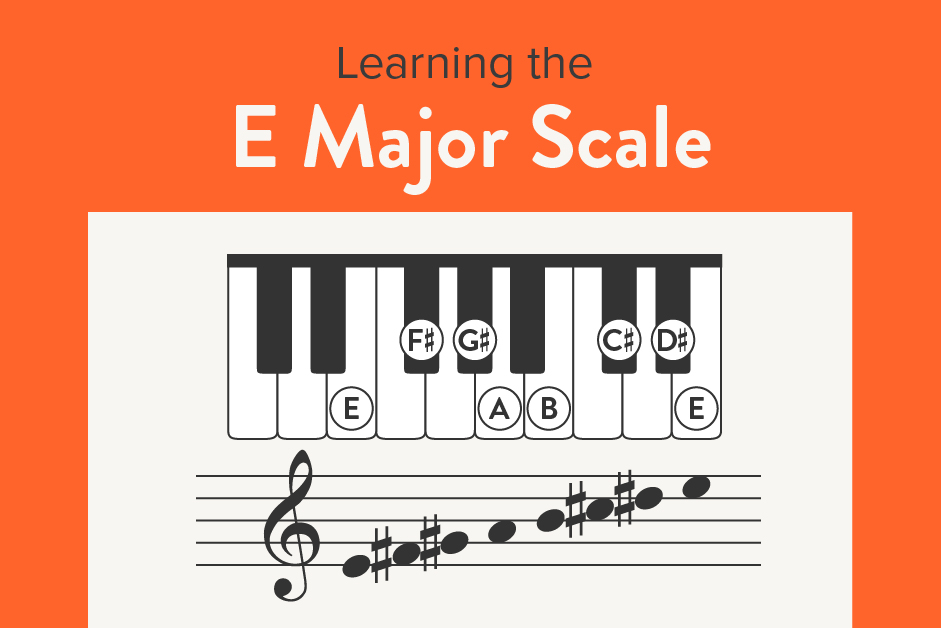Watch how to play the E major scale on piano, and also learn chords and songs in the key of E major
Let’s dive deep into playing the E major scale on piano! In this article, we will learn how to build major scales with a video demonstration of the E major scale and correct finger patterns. The video also demonstrates E major arpeggios and chords.
Want to learn all of the major scales on piano? Download our free Guide to All Major Scales now. To learn more about all kinds of piano scales, check out our All Piano Scales Guide: Major, Minor & More!
What to know about the E major key signature
The key of E major is indicated with four sharps in the key signature and is played using four black keys on the piano – F#, G#, C#, D#. Here is how the key signature looks written out on the treble staff:
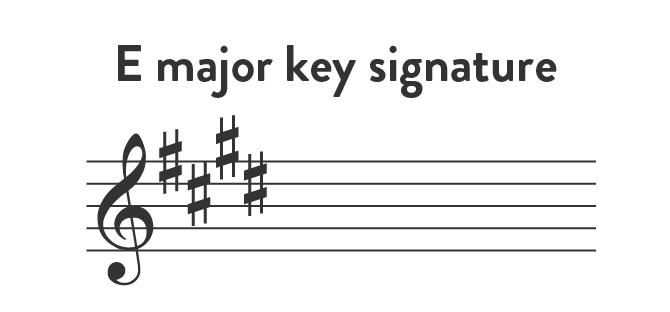
Even though four sharps and four black keys sounds intimidating, E major uses the same finger pattern that C major and G major use for both the left and right hand. So, if you remember Left -54321321 and Right -12312345, and remember to place your thumb on a white key, it is similar to what you have already learned!
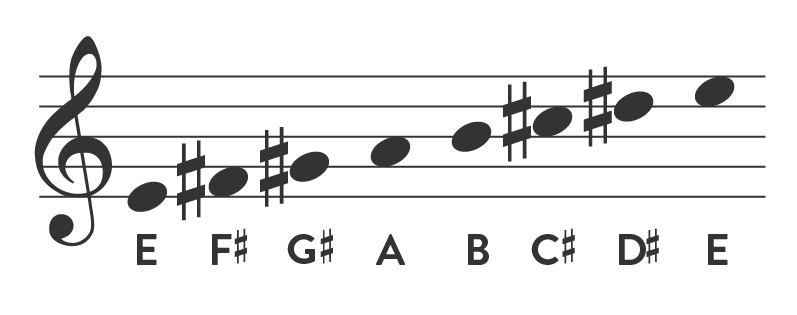
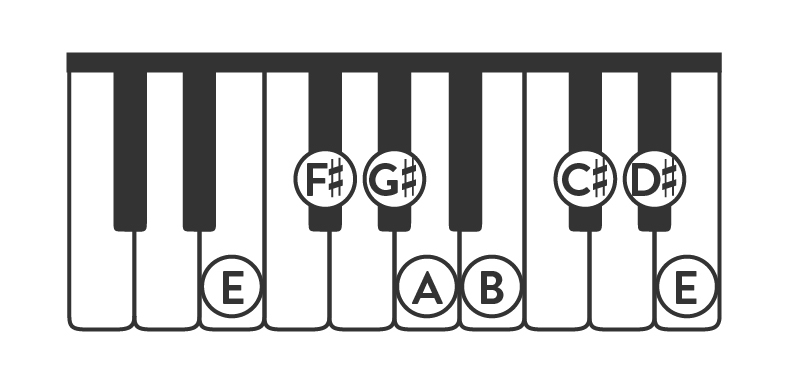
In the tradition of Classical era composers, E major was seen as a bright and powerful key. However, E major and its relative minor C# minor were not common choices for symphonies written by Mozart, Beethoven, and Haydn. Maybe this key signature was thought to be just too perky for the emotional journey of the symphony? You can hear the transformative and bubbly nature of the key at :55 of Mendelssohn’s Violin Concerto, when it modulates to E major from E minor.
To learn more about all kinds of piano scales, check out our All Piano Scales Guide: Major, Minor & More!
How to play E major scale on piano
The E major scale begins on E and has four black keys – F#, G#, C#, D#. Let’s begin by reviewing the relationship between half and whole steps that build a major scale. From the starting note, any major scale is built by going whole step – whole step – half step – whole step – whole step – whole step – half step.
For the right hand, place your right hand thumb on E. Next, go up a whole step to F#, a black key, and play with finger 2. Another whole step with 3 takes us to the black key G# (or mi), followed by a half step to A, crossing over with the thumb. Remember, in a major pentascale, mi and fa are best friends and are close together on the keyboard! Next, we take a whole step to B, then a whole step to the black key C#, then a whole step to the black key D# (known as “ti” in solfege). And now, we’re back at E with our pinky finger!
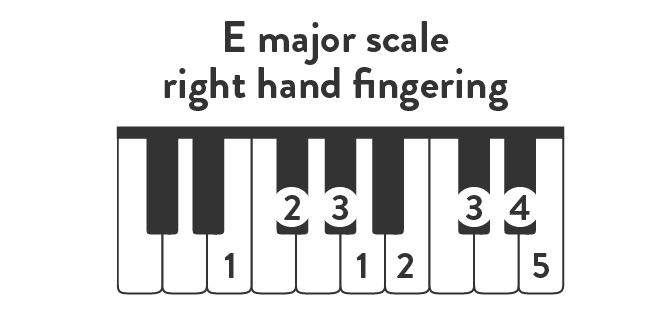
For the left hand, place your right hand finger 5 on E. Next, go up a whole step to F#, a black key, and play with finger 4. Another whole step with 3 takes us to the black key G# (or mi), followed by a half step to A, played with finger 2. Next, we take a whole step to B with finger one, then cross over with finger three a whole step to the black key C#, then a whole step with finger two on the black key D# (known as “ti” in solfege). And now, we’re back at E with our thumb.
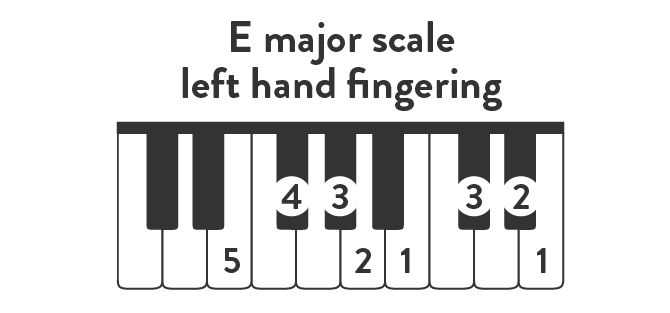
For the descending major scale, repeat the process back down the piano keyboard, using the same finger numbers on each key as you did for the ascending scale. If you are familiar with solfege, the major version in solfege is do – re – mi – fa – so – la – ti – do. It can be tricky to remember that “re” “mi” “la” and “ti” are black keys in E major. If you’re having trouble playing the scale and it doesn’t sound right, double check that you are playing black key G# next to white key A, so that mi and fa are best friends, and that you are playing black key D# as the leading tone back to E, or Do!
The relative minor of E major
Key signatures and scales in music relate to each other in several ways. Major scales have a relative minor scales, with the same key signature, and parallel minor scales, which start on the same note. E major’s relative minor is C# minor. While both of these scales have the same key signature of four sharps, and use the same black keys, they are not the exact same scale. E major’s parallel minor is E minor, which has 1 sharp in the key signature (like G major).
What are piano chords in the key of E major?
You can follow along with the video below to learn and practice Scales, Arpeggios, and Diatonic Chords in E major. Try to keep your fingers relaxed as you practice finding and building these chords, being mindful of your posture.
Most of these chords below are notated in root position using fingers 1 – 3 – 5. In many pieces of music, chords can appear in an “inversion,” which means that the third or fifth note of the scale might be the lowest note of the chord! The chords of the E major scale use the same notes as the scale above. There are four black keys in E major – F#, G#, C#, and D#! To create chords to play with any melody in E major, practicing the arpeggios and diatonic chords in the video above will help the triads that make up these chords feel like second nature. Below, here are tips that will help you build root position chords in E major.
- The E major chord, or tonic chord, is made up of E – G# – B or Do – Mi – So in solfege.
- The next chord built on F# is the supertonic chord, or ii chord. It is a diminished chord, and is made up of F# – A – C#. A diminished chord sounds crunchier than a minor chord because there are fewer half steps between the middle and top notes of the chord. Take a moment and sit at your piano and count the half steps in this chord to see what makes it more “crunchy!”
- Our next chord in E major is the mediant chord, or iii chord. It is notated as G# – C# – E.
- The next chord is a subdominant; the IV chord is major, starts on A, and is written as A – C# – E.
- The V chord, or dominant chord, helps us make chord progressions that sound final. In E major, the V chord is B – D# – F#. it serves as the leading tone in the dominant major chord and helps our ear resolve to A, the tonic.
- The next chord is the submediant, or 6th degree of the scale and it is minor in quality. The notes in this chord are C# – E – G#
- The final chord in E major is our vii chord – D# – F#- A.
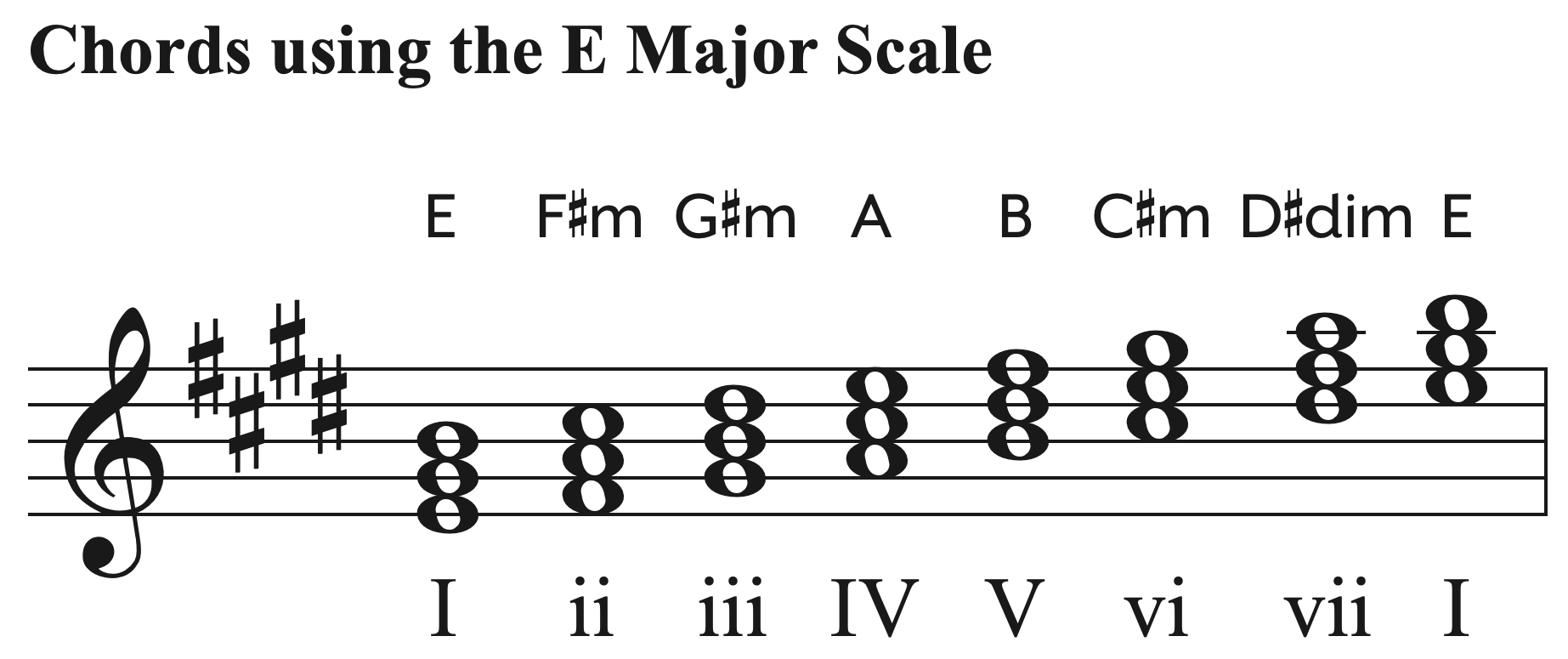
If you’d like some handy reference guides for chords and triads in all keys, download these free resources from the Hoffman Academy Store:
Piano songs in the key of E major to play
If you are just getting started, Mr. Hoffman’s first song in E major is Lesson 42: Love Somebody in unit 3. Allemande in E major, by J.S. Bach is a delightful Baroque piece in E major that will test your knowledge of scales and chords. You can also search the Hoffman Academy Store by “E major” to find more songs to play that use the E major scale on piano!
Ready to take your piano playing to the next level? Try Hoffman Academy Premium Today!




